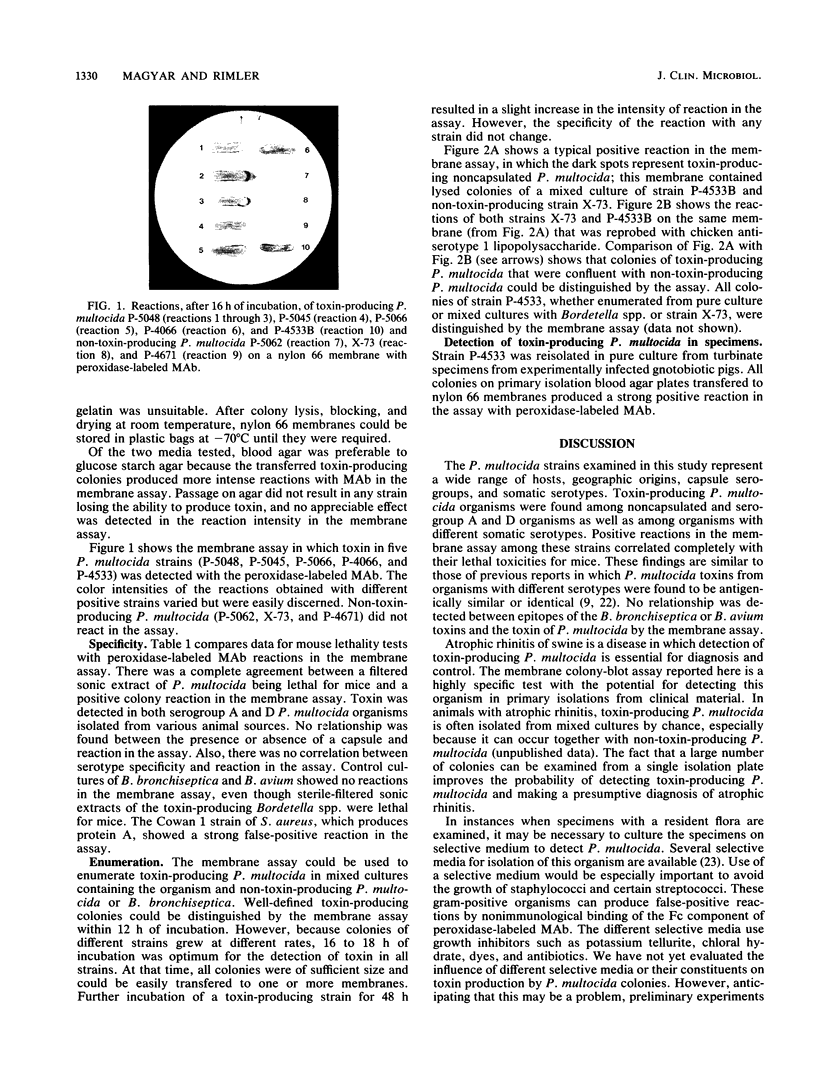Abstract
Colonies of toxin-producing Pasteurella multocida were detected with peroxidase-labeled monoclonal antibodies by a membrane assay. Examination of the specificity of the assay with 29 P. multocida cultures representing various geographic origins, hosts, and serotypes indicated that the test was specific for toxin-producing strains. No cross-reactions were observed with Bordetella species that can be associated with P. multocida in producing diseases in animals. A single membrane could be used to assay several isolated strains for toxin production or to enumerate toxin-producing colonies in mixed cultures. Toxin-producing P. multocida colonies were detected in primary cultures; hence, the assay appears to have good potential for widespread application with clinical samples.
Full text
PDF




Images in this article
Selected References
These references are in PubMed. This may not be the complete list of references from this article.
- Baalsrud K. J. Atrophic rhinitis in goats in Norway. Vet Rec. 1987 Oct 10;121(15):350–353. doi: 10.1136/vr.121.15.350. [DOI] [PubMed] [Google Scholar]
- Chanter N., Magyar T., Rutter J. M. Interactions between Bordetella bronchiseptica and toxigenic Pasteurella multocida in atrophic rhinitis of pigs. Res Vet Sci. 1989 Jul;47(1):48–53. [PubMed] [Google Scholar]
- Chanter N., Rutter J. M., Luther P. D. Rapid detection of toxigenic Pasteurella multocida by an agar overlay method. Vet Rec. 1986 Dec 20;119(25-26):629–630. [PubMed] [Google Scholar]
- Chanter N., Rutter J. M., Mackenzie A. Partial purification of an osteolytic toxin from Pasteurella multocida. J Gen Microbiol. 1986 Apr;132(4):1089–1097. doi: 10.1099/00221287-132-4-1089. [DOI] [PubMed] [Google Scholar]
- Dominick M. A., Rimler R. B. Turbinate atrophy in gnotobiotic pigs intranasally inoculated with protein toxin isolated from type D Pasteurella multocida. Am J Vet Res. 1986 Jul;47(7):1532–1536. [PubMed] [Google Scholar]
- Foged N. T., Nielsen J. P., Pedersen K. B. Differentiation of toxigenic from nontoxigenic isolates of Pasteurella multocida by enzyme-linked immunosorbent assay. J Clin Microbiol. 1988 Jul;26(7):1419–1420. doi: 10.1128/jcm.26.7.1419-1420.1988. [DOI] [PMC free article] [PubMed] [Google Scholar]
- Heddleston K. L., Gallagher J. E., Rebers P. A. Fowl cholera: gel diffusion precipitin test for serotyping Pasteruella multocida from avian species. Avian Dis. 1972 Jul-Sep;16(4):925–936. [PubMed] [Google Scholar]
- Kielstein P. On the occurrence of toxin-producing Pasteurella-multocida-strains in atrophic rhinitis and in pneumonias of swine and cattle. Zentralbl Veterinarmed B. 1986 Aug;33(6):418–424. doi: 10.1111/j.1439-0450.1986.tb00052.x. [DOI] [PubMed] [Google Scholar]
- Magyar T. Study of the toxin-producing ability of Pasteurella multocida in mice. Acta Vet Hung. 1989;37(4):319–325. [PubMed] [Google Scholar]
- Martineau-Doizé B., Frantz J. C., Martineau G. P. Effects of purified Pasteurella multocida dermonecrotoxin on cartilage and bone of the nasal ventral conchae of the piglet. Anat Rec. 1990 Nov;228(3):237–246. doi: 10.1002/ar.1092280302. [DOI] [PubMed] [Google Scholar]
- Nakai T., Sawata A., Tsuji M., Kume K. Characterization of dermonecrotic toxin produced by serotype D strains of Pasteurella multocida. Am J Vet Res. 1984 Nov;45(11):2410–2413. [PubMed] [Google Scholar]
- Nakane P. K., Kawaoi A. Peroxidase-labeled antibody. A new method of conjugation. J Histochem Cytochem. 1974 Dec;22(12):1084–1091. doi: 10.1177/22.12.1084. [DOI] [PubMed] [Google Scholar]
- Nielsen J. P., Bisgaard M., Pedersen K. B. Production of toxin in strains previously classified as Pasteurella multocida. Acta Pathol Microbiol Immunol Scand B. 1986 Jun;94(3):203–204. doi: 10.1111/j.1699-0463.1986.tb03042.x. [DOI] [PubMed] [Google Scholar]
- Pedersen K. B., Barfod K. The aetiological significance of Bordetella bronchiseptica and Pasteurella multocida in atrophic rhinitis of swine. Nord Vet Med. 1981 Dec;33(12):513–522. [PubMed] [Google Scholar]
- Pijoan C., Lastra A., Ramirez C., Leman A. D. Isolation of toxigenic strains of Pasteurella multocida from lungs of pneumonic swine. J Am Vet Med Assoc. 1984 Sep 1;185(5):522–523. [PubMed] [Google Scholar]
- Rhoades K. R., Rimler R. B. Virulence and toxigenicity of capsular serogroup D Pasteurella multocida strains isolated from avian hosts. Avian Dis. 1990 Apr-Jun;34(2):384–388. [PubMed] [Google Scholar]
- Rimler R. B., Angus R. D., Phillips M. Evaluation of the specificity of Pasteurella multocida somatic antigen-typing antisera prepared in chickens, using ribosome-lipopolysaccharide complexes as inocula. Am J Vet Res. 1989 Jan;50(1):29–31. [PubMed] [Google Scholar]
- Rimler R. B., Brogden K. A. Pasteurella multocida isolated from rabbits and swine: serologic types and toxin production. Am J Vet Res. 1986 Apr;47(4):730–737. [PubMed] [Google Scholar]
- Rutter J. M., Luther P. D. Cell culture assay for toxigenic Pasteurella multocida from atrophic rhinitis of pigs. Vet Rec. 1984 Apr 21;114(16):393–396. doi: 10.1136/vr.114.16.393. [DOI] [PubMed] [Google Scholar]
- Rutter J. M., Mackenzie A. Pathogenesis of atrophic rhinitis in pigs: a new perspective. Vet Rec. 1984 Jan 28;114(4):89–90. doi: 10.1136/vr.114.4.89. [DOI] [PubMed] [Google Scholar]
- Rutter J. M. Virulence of Pasteurella multocida in atrophic rhinitis of gnotobiotic pigs infected with Bordetella bronchiseptica. Res Vet Sci. 1983 May;34(3):287–295. [PubMed] [Google Scholar]




